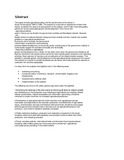Kenya's Agricultural Policy And Sector Performance: 1964 To1996

View/
Date
1998-10Author
Nyangito, Hezron
Okello, Julius
Type
VideoLanguage
enMetadata
Show full item recordAbstract
T
his paper reviews agricultural policy and the performance of the sector in
Kenya for the period 1964 to 1996. The purpose is to provide an opportunity to learn from
history: to identify the weak and strong points of the policies, and to help in providing policy
options for future sustainable growth and development. From the review
, agricultural policies
used in Kenya can be divided into government controls and liberalised markets. However
, the
bipolar division of policies between full government controls and free markets has created
problems in agricultural development.
During the era of controls, the governmentí
s domination of production and marketing
activities stifled development of the private sector and because of the government inability to
continuously support the activities financially and technically
, there was a decline in agricultural
growth and development as a whole. On the other hand, when the government started to off-
load the activities to the private sector and let the free markets guide production and marketing
activities, there was lack of harmony and co-ordination of the implementation process. This
resulted in retarded growth and development of the agricultural sector because of the vacuum
that existed as a result of a poorly developed private sector which also lacked the capacity to
undertake the activities adequately
.
It is clear from the analysis that rigidities exist in the following areas:
ï
marketing and pricing;
ï
investment policy in extension, research, animal health, irrigation and
infrastructure;
ï
macroeconomic policies used;
ï
implementation of the policies.
The following are some of the policy options required to relax the rigidities:
1.
Enhancing the workings of the free market by removing all direct or indirect controls
and interference on the production and marketing of agricultural commodities. Market
failures (externalities, natural monopolies and information asymmetry) should be
corrected to create incentives for increased agricultural production.
2.
Privatisation of agricultural services which promise to be appealing to private
individuals and organisations (for example, production and distribution of agricultural
inputs, mechanisation services and livestock clinical services) should be encouraged
while the government should invest in services such as agricultural research and
extension, and control of epidemic diseases and pests.
3.
Public institutions dealing in production and marketing of products in this sector
should be reformed to deal with regulatory and advisory functions rather than direct
production and marketing activities.
4.
Fiscal, monetary policies, international trade and domestic financing procedures
should be able to allow producers and consumers to benefit from agricultural
commodity prices prevailing in the world markets
URI
http://www1.chr.up.ac.za/chr_old/indigenous/documents/Kenya/Report/Kenya%27s%20Agricultural%20Policy%20and%20Sector%20Performance.pdfhttp://hdl.handle.net/11295/61434
Citation
Nyangito, H., & Okello, J. (1998). KENYA’S AGRICULTURAL POLICY AND SECTOR PERFORMANCE: 1964 to1996.Publisher
Agricultural Economics
Collections
- School of Economics [105]
